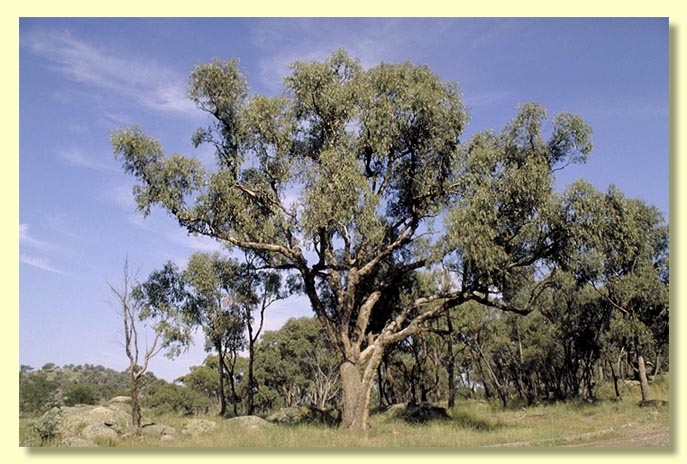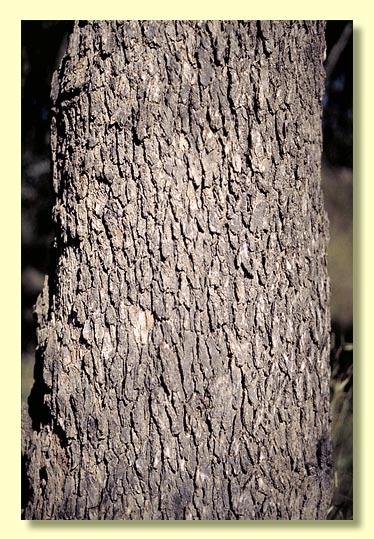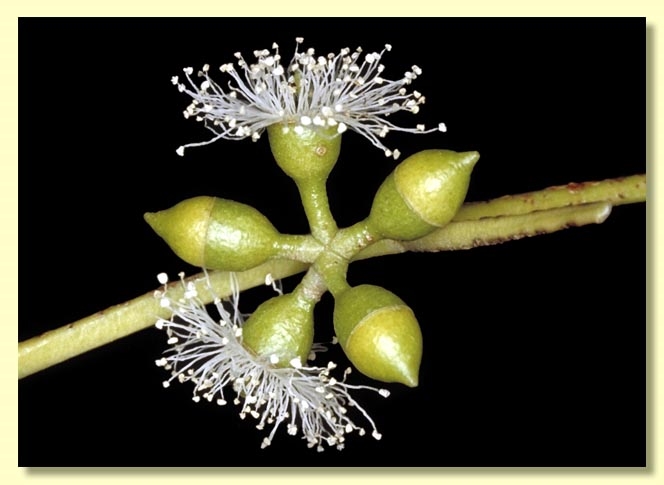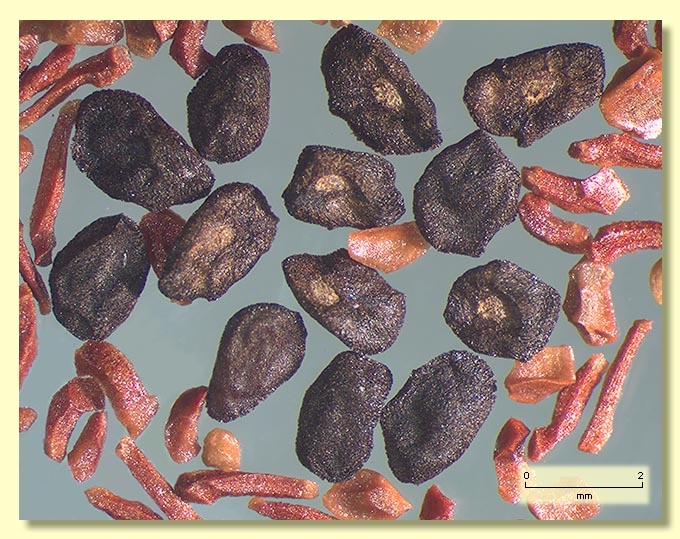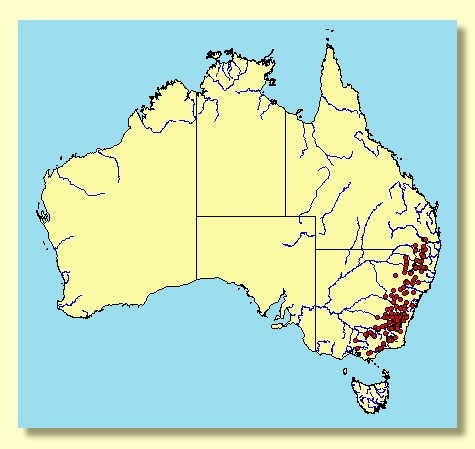Euclid - Online edition
Eucalyptus bridgesiana
Eucalyptus | Symphyomyrtus | Maidenaria | Euryotae | Bridgesiana
T: New South Wales. Albury, Andrews s.n. 21 June 1897; lecto: NSW [NSW314589]; fide Bean, A.R., Telopea 12(3): 310 (2009).
E. bridgesiana var. amblycorys (Blakely) Cameron, Victorian Naturalist 63: 41 (1946); E. stuartiana var. amblycorys Blakely, Key Eucalypts 145 (1934). T: Tumut, NSW, Jan. 1897, E.Betche s.n.; holo: NSW.
E. saxicola J.T.Hunter, Telopea 9 (2) 403 (2001). T: New South Wales: Central Tablelands: Mt Canobolas State Recreation Area, c. 14 km south-west of Orange, 33° 20' 11" S, 154° 58' 22" E, on margin of trachyte outcrop, 1200 m altitude, J.T.Hunter 8556, 2 June 1998; holo: NSW; iso: BRI, CANB, MEL (the CANB specimen not located at time of publication).
[E. stuartiana auct. non F.Muell. ex Miq.: A.K.Cameron, Victorian Naturalist 62: 47–50 (1945).]
Bark rough over whole trunk and larger branches, fibrous, usually tessellated and mottled grey and white.
Juvenile growth (coppice or field seedlings to 50 cm): stem rounded in cross-section, usually glaucous, warty, or smooth; juvenile leaves sessile, opposite for many pairs, becoming shortly petiolate and disjunct, orbicular to ovate or cordate, 2.5–10 cm long, 2–8 cm wide, margin crenulate, glaucous.
Adult leaves alternate, petiole 1.2–3.5 cm; blade lanceolate, 12–20 cm long, 1.5–2.5 cm wide, concolorous, glossy, green; side-veins at an acute or sometimes wider angle to midrib, reticulation moderate to dense, intramarginal vein parallel to and well removed from margin, with few small island oil glands, sometimes apparently glandless.
Inflorescence axillary, unbranched; peduncles to 1.5 cm long, buds 7 per umbel, pedicels 0.1–0.5 cm long. Mature buds ovoid, 0.5–0.8 cm long, 0.3–0.5 cm wide, scar present; operculum beaked or conical; stamens irregularly flexed, anthers dorsifixed, versatile, cuneate, dehiscing by longitudinal slits, locules 3(4), the placentae each with ovules in 4 vertical rows. Flowers white.
Fruit pedicellate or rarely sessile (pedicels 0–0.3 cm long), hemispherical, 0.3–0.7 cm long, 0.4–0.8 cm wide, disc raised-annular; valves 3(4), exserted.
Seeds brownish black, ovoid or flattened-ovoid, usually lacunose, dorsal surface shallowly pitted, hilum ventral.
Cultivated seedlings (measured at ca node 10): cotyledons bilobed; stems rounded in cross-section, glaucous or rarely green, usually warty; leaves opposite and sessile for ca 3 nodes then becoming characteristically disjunct for many nodes, sessile or shortly petiolate, cordate to orbicular, 3.5–5.5 cm long, 3–4.5 cm wide, base amplexicaul to lobed, margin crenulate, apex rounded, broadly pointed or emarginate, usually glaucous, rarely green.
Flowering has been recorded in January, February, March and May.
A small to medium-sized woodland tree of central and eastern Victoria, the tablelands of New South Wales and the far south-east of Queensland. It has rough, tessellated grey bark usually extending to the limbs and a glossy green crown and non-glaucous buds and fruit. The form of E. bridgesiana on the western side of the Northern Tablelands has very conspicuous glaucous stems and leaves on saplings to > 2 m tall.
Eucalyptus bridgesiana belongs in Eucalyptus subgenus Symphyomyrtus section Maidenaria, a large group of species more or less restricted to south-eastern Australia, characterised by bilobed cotyledons, simple axillary inflorescences, buds with two opercula, stamens with versatile anthers and flattened seeds with a ventral hilum. Within this section, E. bridgesiana belongs in series Bridgesianae having rough bark, ovate, crenulate juvenile leaves sub-opposite to alternate for many nodes, small ovoid buds in sevens, and small fruit with exserted valves. The other species in series Bridgesianae are E. angophoroides, a rough-barked tree of better quality sites in south coastal New South Wales and East Gippsland in Victoria, with slightly discolorous adult leaves and green juvenile leaves; E. malacoxylon, a rough-barked tree restricted to the Moonbi area of the Northern Tablelands of New South Wales, with concolorous leaves and larger, glaucous buds with a medial flange and glaucous fruits; and E. dunnii, a tall forest tree of subcoastal hills and ranges of northern New South Wales, which is only rough at the base, smooth-barked above and has green juvenile leaves. Two other rough-barked species sometimes confused with E. bridgesiana are E. goniocalyx subsp. goniocalyx, and E. nova-anglica. Both these species have strictly opposite juvenile leaves, not sub-opposite as in E. bridgesiana and thus can be rapidly distinguished..
In 2001 Eucalyptus saxicola was described from small populations near the summit of Mount Canobolas, near Bathurst, New South Wales, stated as differing from E. bridgesiana primarily in having smaller juvenile leaves (< 4 cm wide and long), more hemispherical operculum, and in being a smaller plant. From our field and herbarium experience E. bridgesiana frequently has juvenile leaves < 4 cm wide and long, and opercula varying from conical to hemispherical, often with a beak or apiculum, throughout its wide geographic range from Stanthorpe and Ballandean in Queensland south to Suggan Buggan, Bairnsdale and Glenrowan in Victoria. Stature, flatness of the peduncles and length of the pedicels also are variable throughout the species range. The Mount Canobolas populations lack the exserted valves of the fruit typical of E. bridgesiana, a feature worthy of note but insufficient to maintain a species difference. We therefore synonymise E. saxicola with E. bridgesiana. Similarly a population of plants from Howe's Swamp in the Colo area north-west of Sydney has been informally named "Eucalyptus wollemiensis" – it scarcely differs from E. bridgesiana , having small juvenile leaves and less prominently erect though still exserted valves.

